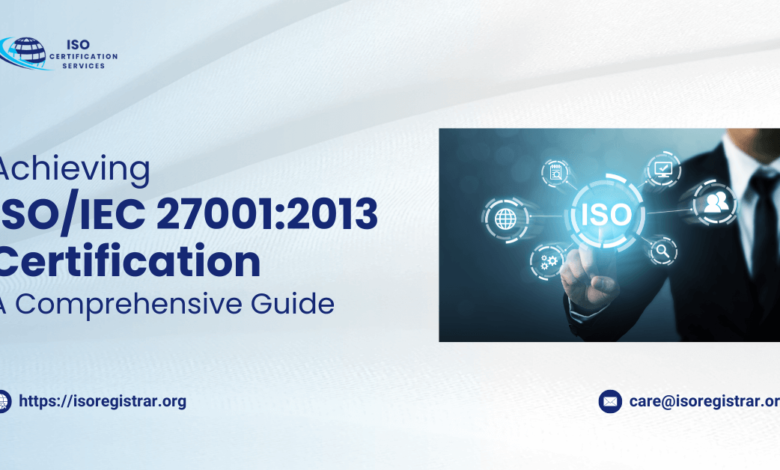Achieving ISO/IEC 27001:2013 Certification: A Comprehensive Guide

In today’s digital age, where information is a critical asset, ensuring its security is paramount. Organizations across the globe face a myriad of threats that can compromise the integrity, confidentiality, and availability of their information. To combat these threats, many turn to ISO/IEC 27001:2013 certification, a globally recognized standard for information security management systems (ISMS). This certification provides a robust framework for managing and protecting sensitive information, offering peace of mind to stakeholders and demonstrating a commitment to information security.
What is ISO/IEC 27001:2013?
ISO/IEC 27001:2013 is an international standard jointly published by the International Organization for Standardization (ISO) and the International Electrotechnical Commission (IEC). It specifies the requirements for establishing, implementing, maintaining, and continually improving an ISMS. The standard’s main objective is to help organizations manage and protect their information systematically and cost-effectively, adopting a risk management approach.
The 2013 revision of ISO/IEC 27001 introduced significant improvements over its predecessor. It aligned with other ISO management system standards, such as ISO 9001 (Quality Management) and ISO 14001 (Environmental Management), making it easier for organizations to integrate multiple management systems. It also adopted a more flexible approach, allowing organizations of all sizes and sectors to tailor the standard to their specific needs.
Key Components of ISO/IEC 27001:2013
The ISO/IEC 27001:2013 standard is structured around several key components that form the backbone of an effective ISMS:
Context of the Organization:
Understanding the internal and external issues that can impact the ISMS, identifying stakeholders, and defining the scope of the ISMS.
Leadership:
Top management must demonstrate leadership and commitment to the ISMS, establishing an information security policy, assigning roles and responsibilities, and ensuring adequate resources.
Planning:
Organizations must identify and assess information security risks and opportunities, setting clear objectives and plans to address them.
Support:
Ensuring the availability of resources, competence, awareness, communication, and documented information necessary for the ISMS.
Operation:
Implementing the plans and processes needed to achieve information security objectives, including risk treatment plans and incident response procedures.
Performance Evaluation:
Monitoring, measuring, analyzing, and evaluating the performance of the ISMS, conducting internal audits, and management reviews.
Improvement:
Identifying nonconformities and taking corrective actions to continually improve the ISMS.
The Certification Process
Achieving ISO/IEC 27001:2013 certification involves a rigorous process that typically includes the following steps:
Gap Analysis:
Assessing the current state of the organization’s information security practices against the requirements of the standard to identify gaps and areas for improvement.
ISMS Implementation:
Developing and implementing the necessary policies, procedures, and controls to address the identified gaps and meet the standard’s requirements.
Internal Audit:
Conducting an internal audit to verify that the ISMS is effectively implemented and compliant with ISO/IEC 27001:2013.
Management Review:
Top management reviews the ISMS to ensure its ongoing suitability, adequacy, and effectiveness.
Certification Audit:
An independent certification body conducts a two-stage audit. Stage 1 involves a documentation review to ensure the ISMS meets the standard’s requirements. Stage 2 involves an on-site audit to verify the implementation and effectiveness of the ISMS.
Certification Decision:
Based on the audit findings, the certification body decides whether to grant ISO/IEC 27001:2013 certification.
Surveillance Audits:
Regular surveillance audits (typically annually) are conducted by the certification body to ensure the ISMS continues to meet the standard’s requirements.
Benefits of ISO/IEC 27001:2013 Certification
Obtaining ISO/IEC 27001:2013 certification offers numerous benefits to organizations:
Enhanced Information Security:
Implementing a robust ISMS helps protect sensitive information from a wide range of threats, reducing the risk of data breaches and cyberattacks.
Regulatory Compliance:
Certification demonstrates compliance with various legal, regulatory, and contractual requirements related to information security.
Improved Business Reputation:
Achieving certification signals to clients, partners, and stakeholders that the organization is committed to information security, enhancing trust and credibility.
Risk Management:
The standard’s risk-based approach helps organizations identify, assess, and mitigate information security risks more effectively.
Operational Efficiency:
Implementing an ISMS can streamline information security processes, reducing redundancy and improving efficiency.
Competitive Advantage:
Certification can provide a competitive edge, particularly in industries where information security is a critical concern.
Continuous Improvement:
The focus on continual improvement ensures that the ISMS evolves to address emerging threats and changing business needs.
Challenges and Considerations
While ISO/IEC 27001:2013 certification offers many benefits, organizations may face several challenges during the certification process:
Resource Allocation:
Implementing and maintaining an ISMS requires significant resources, including time, personnel, and financial investment.
Change Management:
Adapting to new policies and procedures can be challenging for employees, necessitating effective change management strategies and training programs.
Maintaining Compliance:
Continual compliance with the standard’s requirements requires ongoing effort, including regular audits, reviews, and updates to the ISMS.
Integration with Other Systems:
Organizations with multiple management systems may need to integrate ISO/IEC 27001:2013 with other standards, which can be complex.
Balancing Security and Usability:
Implementing stringent security controls can sometimes impact the usability and functionality of information systems, requiring a balance between security and user needs.
Note: Apply for ISO certificate through our official portal
Conclusion
ISO/IEC 27001:2013 certification is a valuable tool for organizations seeking to protect their information assets and demonstrate their commitment to information security. By following the standard’s comprehensive framework, organizations can effectively manage information security risks, enhance their reputation, and gain a competitive advantage. Despite the challenges involved, the benefits of certification far outweigh the costs, making it a worthwhile investment for any organization serious about safeguarding its information in an increasingly digital world.



